Hydraulic Radial Drilling Using a Rotary Hydraulic Nozzle Aimed at Increasing the Exploitation of Deposits
Abstract
1. Introduction
- This study explores how the effectiveness of the jet is influenced by the distance between the hydraulic drilling nozzle toolface and the rock formation being cut.
- Effective range of the jet: This research considers the effective range of the jet in relation to the diameter of the openings in the nozzle.
- Determining the discharge velocity from the hydraulic drilling nozzle openings is crucial in understanding the performance of the system.
- This study aims to determine the contraction coefficients of the rotary nozzle, providing insights into the hydraulic energy transferred by the working fluid.
2. Recoverable Reserves of Natural Gas from Deposits Located in Coal Seams
3. The Idea of Using Small-Diameter Radial Boreholes as an EOR Method for Deposits with Low Reservoir Energy and Destined for Decommissioning
4. Technology of Reaming Deposits with Small-Diameter Radial Holes
4.1. Technological Solutions
- pulling out production equipment from the well and existing downhole equipment.
- cleaning the borehole to ensure optimal conditions for drilling.
- casing on the production tubing or drill pipe to the specified depth of the downhole set, enabling the creation of a window in the casing pipe.
- making a window in the casing with a window-cutting tool.
- arming the capillary with a flexible pressure hose with a nozzle and launching into the deflector, starting drilling to the set length.
- retracting the drilling set from the hole with simultaneous flushing of the hole from the borings.
- repositioning and redrilling: pulling out the drilling set, unhooking the anchor, changing the orientation of the deflector, fastening the anchor, and drilling another window and borehole if required.
- completing the operation by pulling out the downhole set and fastening the production equipment to the well.
- The deflector provides direction to the rotary head. It is secured to the horizontal section of the existing wellbore using a support conduit, which can be either production tubing or drill pipe, depending on the specific components employed in the particular wellbore.
- The rotary head is oriented at an angle to the existing horizontal section of the drill hole through the deflector channel of the deflector, which is fastened to the casing pipes and anchored using an anchor.
- The anchor secures the deflector to the casing pipes, ensuring stability during the drilling process.
- The rotary head is mounted on the end of the high-pressure flexible tubing, which is connected to the drilling fluid circulation system through the coiled tubing (CT).
- The packer is positioned in front of the deflector anchor; the packer facilitates separation from the rest of the horizontal borehole.
4.2. Benefits of Technology Used in Industry
- obtaining data for making precise decisions regarding reconstruction, reaming, implementing costly intensification procedures, or decommissioning a low-productivity well.
- a distinctive approach to gathering data on the actual anisotropy of the reservoir layer for a directional drilling project (depth, direction). This is aimed at achieving maximum effectiveness and minimizing the risk of misguided investments.
- a cost-effective means of enhancing the exploitation of hydrocarbon reservoirs with a damaged near-wellbore zone or those requiring simple production-enhancement procedures.
- boosting production from reservoirs with low-permeability layers by cost-effectively reaming the production seam through reduced drilling operations.
- increasing hydrocarbon production by expanding the contact area between the well and the reservoir rock.
- low-cost exploration (or access at low capacities) of prospective production horizons in existing oil wells.
- allowing the drilling of small-diameter holes at various angles relative to each other and at different angles from the horizontal hole.
5. Hydraulic Drilling Nozzle—Surface Testing
Determination of the Geometry of the Stream Flowing out of the Openings of the Rotary Drilling Nozzle
6. Discussion
7. Conclusions
- The implementation of a hydraulic drilling head necessitates the utilization of a sophisticated technology developed during the study period. The central component of this technology is a coiled tubing unit equipped with an array of devices and components. These are installed at the end of the drill window in the casing, facilitating the insertion of the designed drilling nozzle in the direction of the reservoir layer.
- The technological solution involves accessing and extracting methane from deposits located in coal seams. The process is initiated by drilling a borehole to expose methane deposits situated in coal formations. This is achieved by drilling a straight vertical borehole, accompanied by a horizontal section within the coal overburden layer. Subsequently, small-diameter openings are drilled into the coal seam by employing hydraulic drilling nozzles, as illustrated in Figure 1.
- The invented technology will contribute to the increased exploitation of hydrocarbon deposits, particularly in damaged near-wellbore zones or those requiring simple intensification methods. This enhancement is achieved by expanding the contact area of the main wellbore with the reservoir layer.
- The application of this technology in methane extraction from coal deposits promises safe degassing, coupled with economic benefits.
- The stream disperses in geometry after exiting the outlets, making it crucial to determine the maximum length of the stream that corresponds to the minimum hydraulic energy required for unimpeded drilling in the reservoir layer.
- The research conducted confirms the dependence of the jet length on pressure and allows for the identification of the minimum jet length based on the diameter of the outlet as a function of pressure. This information is crucial to determine the hydraulic energy required for the effective excavation of the rock layer and the safe entry of the nozzle into the geological formation being excavated.
- During the hydraulic drilling process, the nozzles must move freely through the hydraulically excavated formation into its interior during the drilling of a small-diameter radial hole. However, as the depth of the radial holes increases, pressure losses in the drilling fluid circulation system will cause a decrease in drilling quality. This, in turn, results in a reduction in the diameter of the radial hole, ultimately leading to a blockage of the head feed.
- Modifying the head and/or designing the drilling head to increase the diameter of the propagated radial hole will directly impact the depth of drilling small-diameter holes.
Author Contributions
Funding
Data Availability Statement
Conflicts of Interest
References
- Gonet, A.; Nagy, S.; Rybicki, C.; Siemek, J.; Stryczek, S.; Wiśniowski, R. Technologia Wydobycia Metanu z Pokładów Węgla Kamiennego. Górnictwo I Geologia. AGH 2010, 5, 3. [Google Scholar]
- Baran, P.; Rogozińska, J.; Zarębska, K.; Porada, S. Analiza Układu Węgiel Kamienny—Gaz pod Kątem Intensyfikacji Wydobycia Metanu z Użyciem Ditlenku Węgla. Przemysł Chem. 2014, 93, 12. [Google Scholar]
- Artymiuk, J.; Kiełbik, W. Koncepcja Odmetanowania Pokładów Węgla Otworami Wiertniczymi w KWK Szczygłowice. Wiert. Naft. Gaz 2007, 24, 1. [Google Scholar]
- Dickinson Ben, W.O.; Dickinson, R.W. Horizontal Radial Drilling System. In Proceedings of the SPE California Regional Meeting, Bakersfield, CA, USA, 27–29 March 1985. [Google Scholar] [CrossRef]
- Dickinson Ben, W.O.; Dykstra, H.; Nees, J.M.; Dickinson, E. The Ultrashort Radius Radial System Applied to Thermal Recovery of Heavy Oil. In Proceedings of the SPE Western Regional Meeting, Bakersfield, CA, USA, 30 March–1 April 1992. [Google Scholar] [CrossRef]
- Tianyu, W.; Qingling, L.; Bin, Z.; Shouceng, T.; Gensheng, L.; Zhaoquan, G. Fracture Initiation Characteristics from Multiple Radial Wellbores. In Proceedings of the 54th US Rock Mechanics/Geomechanics Syposium, Physical Event Cancelled, Golden, CO, USA, 28 June–1 July 2020. [Google Scholar]
- Ibeh, S.; Obah, B.; Chibuze, S. Investigating the Application of Radial Drilling Technique for Improved Recovery in Mature Niger Delta Oil Fields. In Proceedings of the Nigeria Annual International Conference and Exhibition, Lagos, Nigeria, 31 July–2 August 2017. [Google Scholar]
- Wiśniowski, R.; Knez, D.; Hytroś, Ł. Drillability and Mechanical Specific Energy Analysis on The Example of Drilling in The Pomeranian Basin. AGH Drill. Oil Gas 2015, 32, 201. [Google Scholar] [CrossRef][Green Version]
- Buset, P.; Riiber, M.; Arne, E. Jet Drilling Tool: Cost-effective Lateral Drilling Technology for Enhanced Oil Recovery. Paper SPE 68504. Presented at the SPE/ICoTA Coiled Tubing Roundtable, Houston, TX, USA, 7–8 March 2001. [Google Scholar]
- Abdel-Ghany, M.A.; Siso, S.; Hassan, A.M. New Technology Application, Radial Drilling Petrobel, First Well in Egypt. Paper OMC-2011-163. Presented at the 10th Offshore Mediterranean Conference and Exhibition, Ravenna, Italy, 23–25 March 2011. [Google Scholar]
- Rychlicki, S. Możliwości Zwiększenia Efektywności Wydobycia Ropy Naftowej ze Złóż Karpackich; Wydawnictwa Naukowe AGH: Krakow, Poland, 2010; 184p. [Google Scholar]
- Wojnarowski, P.; Stopa, J.; Janiga, D.; Piotr, K. Możliwości, Zwiększenia, Wydobycia Ropy Naftowej w Polsce z Zastosowaniem Zaawansowanych Technologii, Polityka Energetyczna. Energy Policy J. 2015, 18, 4. [Google Scholar]
- Yan, C.; Ren, X.; Cheng, Y.; Deng, F.; Zhang, J.; Li, Q. An Experimental Study on the Hydraulic Fracturing of Radial Horizontal Wells. Geomech. Eng. 2019, 17, 535–541. [Google Scholar] [CrossRef]
- Koulidis, A.; Pelfrene, G.; Ahmed, S. Experimental investigation of the rock cutting process and derivation of the 3D spatial distribution of the formation strength using in-cutter sensing. J. Pet. Explor. Prod. Technol. 2023. [Google Scholar] [CrossRef]
- Chi, H.; Li, G.; Huang, Z.; Tian, S.; Song, X. Maximum drillable length of the radiala horizontal micro-hole drilled with multiple high pressure water jets. J. Nat. Gas Sci. Eng. 2015, 26, 1042–1049. [Google Scholar] [CrossRef]
- Cinelli, S.D.; Kamel, A.H. Novel Technique to Drill Horizontal Laterals Revitalizes Aging Field. In Proceedings of the SPE/IADC Drilling Conference, Amsterdam, The Netherlands, 5–7 March 2013. [Google Scholar] [CrossRef]
- Jeffryes, B.P. Schlumberger Oilfield Research, Novel Drilling Techniques, Chapter 9.5. In Advanced Drilling and Well Technology; SPE: Willis, TX, USA, 2009. [Google Scholar]
- Salem Ragab, A.M. Improving well Productivity in an Egyptian Oil Feld Using Radial Drilling Technique. J. Pet. Gas Eng. 2013, 4, 103–117. [Google Scholar] [CrossRef]
- Liu, Q.; Tian, S.; Li, G.; Shen, Z.; Huang, Z.; Sheng, M.; Zhang, Z. Experimental Study of Radial Drilling-Fracturing for Coalbed Methane. In Proceedings of the 51st U.S. Rock Mechanics/Geomechanics Symposium, San Francisco, CA, USA, 25–28 June 2017. ARMA-2017-0110. [Google Scholar]
- Wiśniowski, R.; Teper, W.; Zwierzyński, A.J.; Złotkowski, A.; Toczek, P. Sposób, Powierzchniowego Odmetanowania Formacji Geologicznej Zawierającej Złoże Węgla Kamiennego, Patent PL436375A1. 2020. Available online: https://worldwide.espacenet.com/patent/search/family/082021230/publication/PL436375A1?q=ap%3DPL436375%2A (accessed on 1 September 2023).
- Stayton, R.J. Method for Drilling with Improved Fluid Collection Pattern. U.S. Patent 0266517 A1, 30 November 2006. [Google Scholar]
- Poole, J.M. Forming Multiple Deviated Wellbore. U.S. Patent 0005762, 13 January 2011. [Google Scholar]
- Foundas, E.; Bresnehan, R.M. Recovery or storage Process, 2017. CA Patent 2749591, 18 April 2017. [Google Scholar]
- William, C.M. Drain Hole Drilling in a Fractured Reservoir. U.S. Patent 0030180 A1, 2 February 2017. [Google Scholar]
- Quingling, L.; Shouceng, T.; Gensheng, L.; Mao SKamy, S.; Haizu, W.; Ruyue, M.; Zhaoguan, G.; Lidong, G. Influence of Weakness Plane on Radial Drilling with Hydraulic Fracturing Initiation. In Proceedings of the 52nd U.S. Rock Mechanics/Geomechanics Symposium, Seattle, WA, USA, 17–20 June 2018. [Google Scholar]
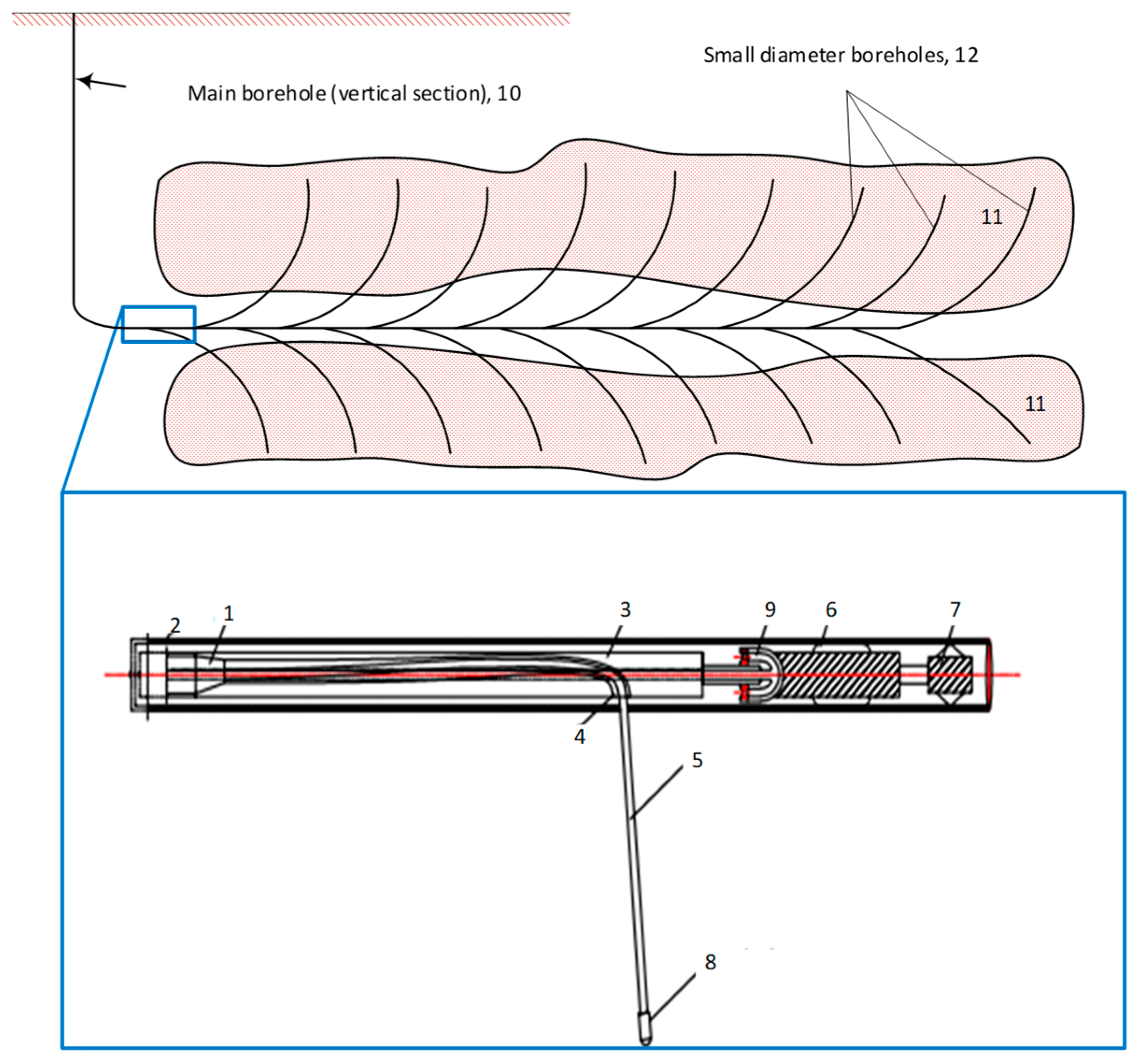

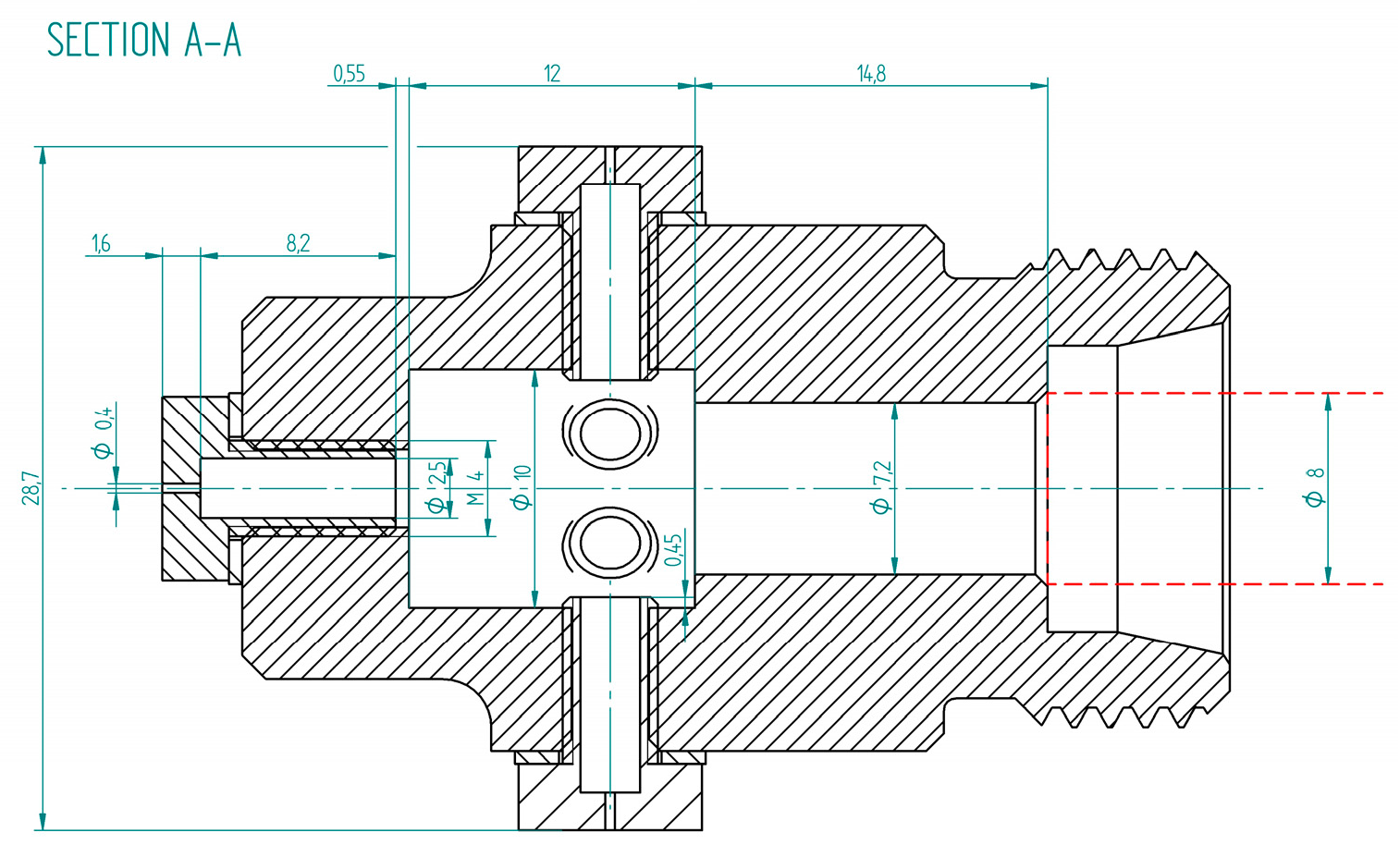
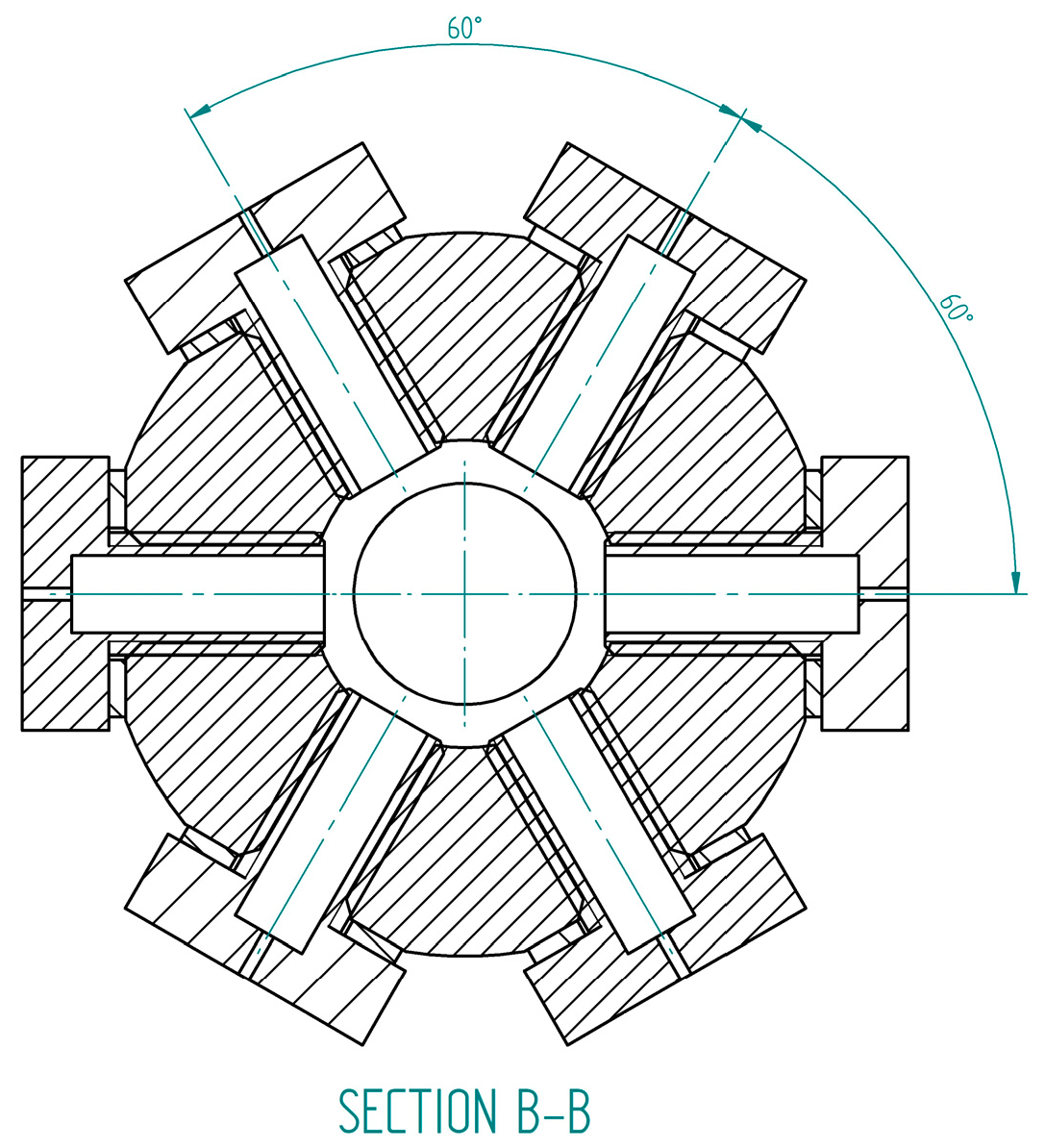
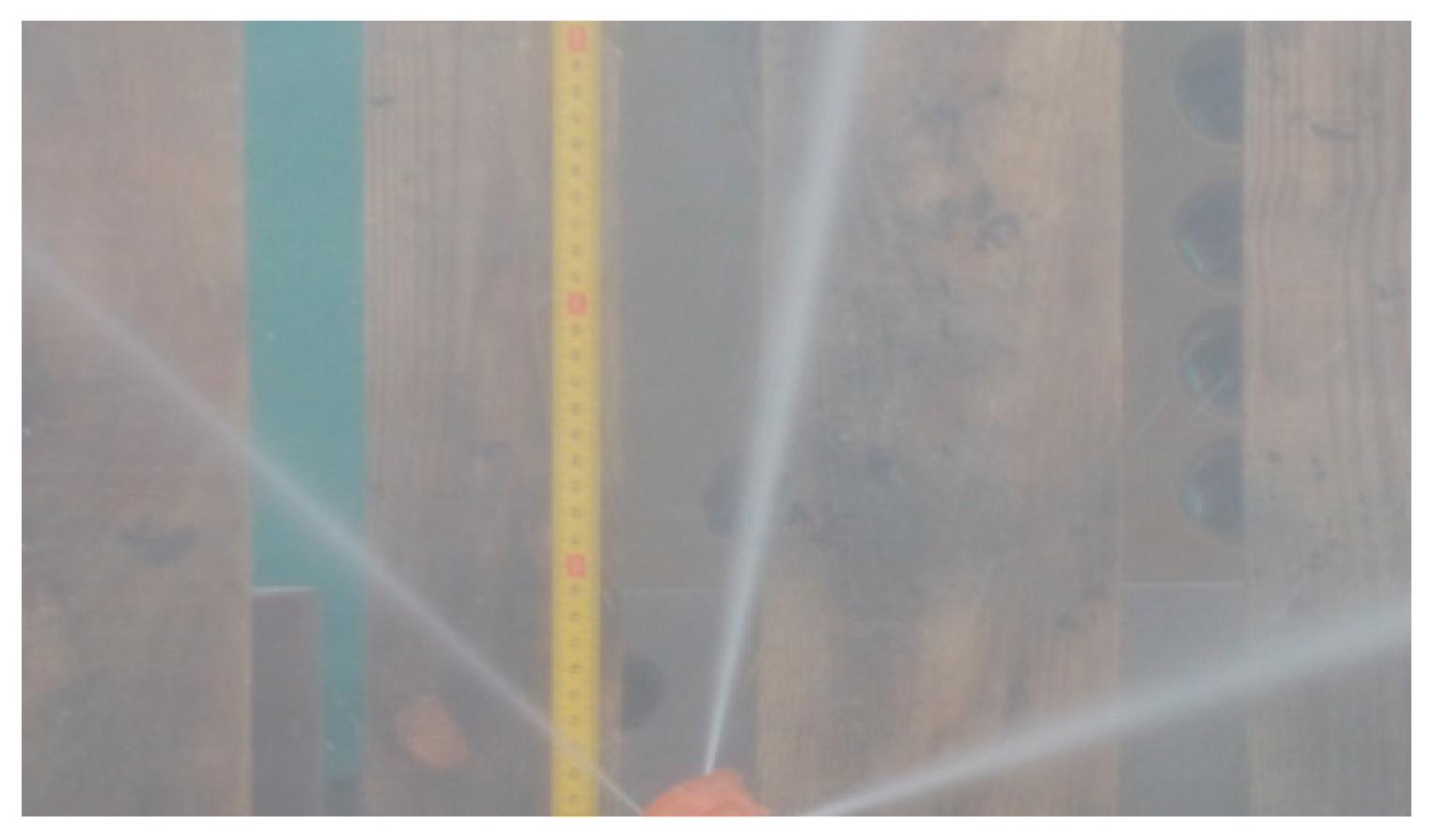


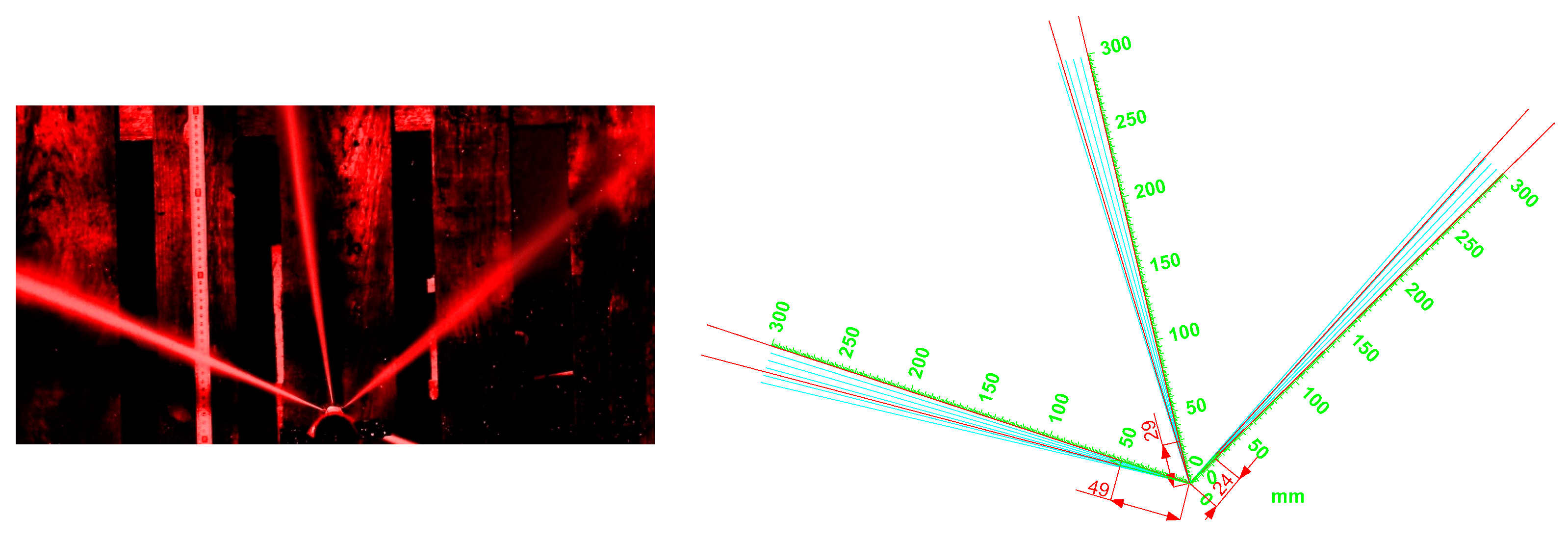
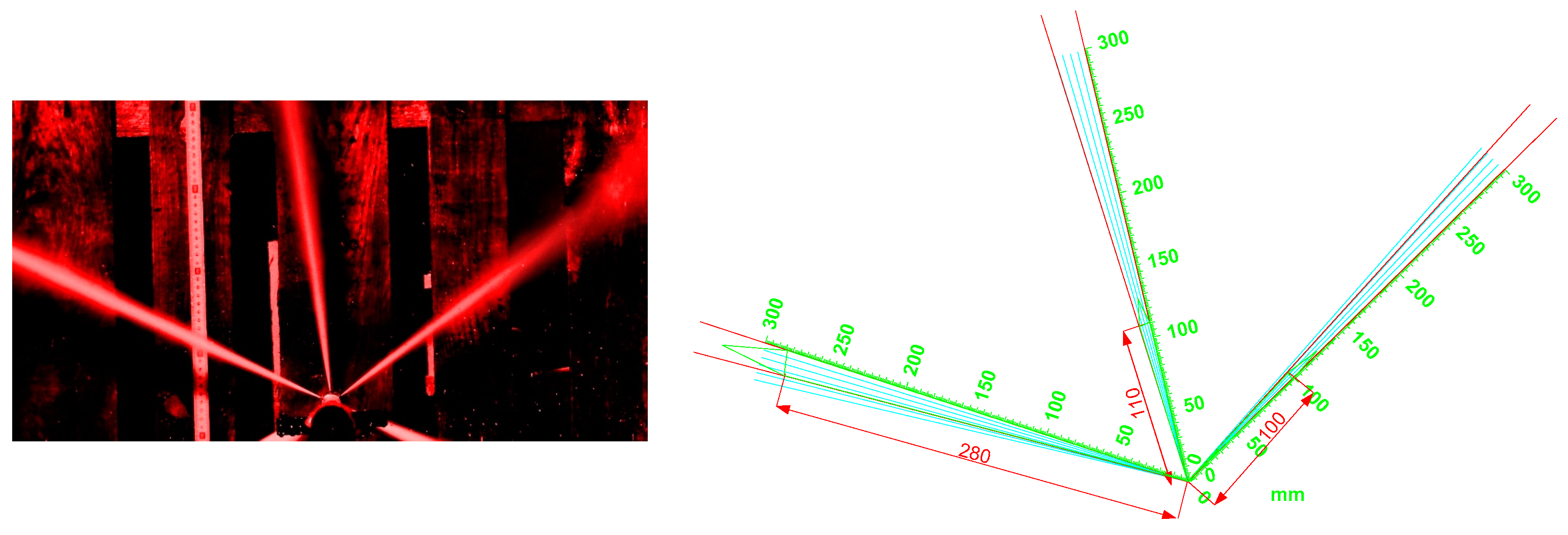



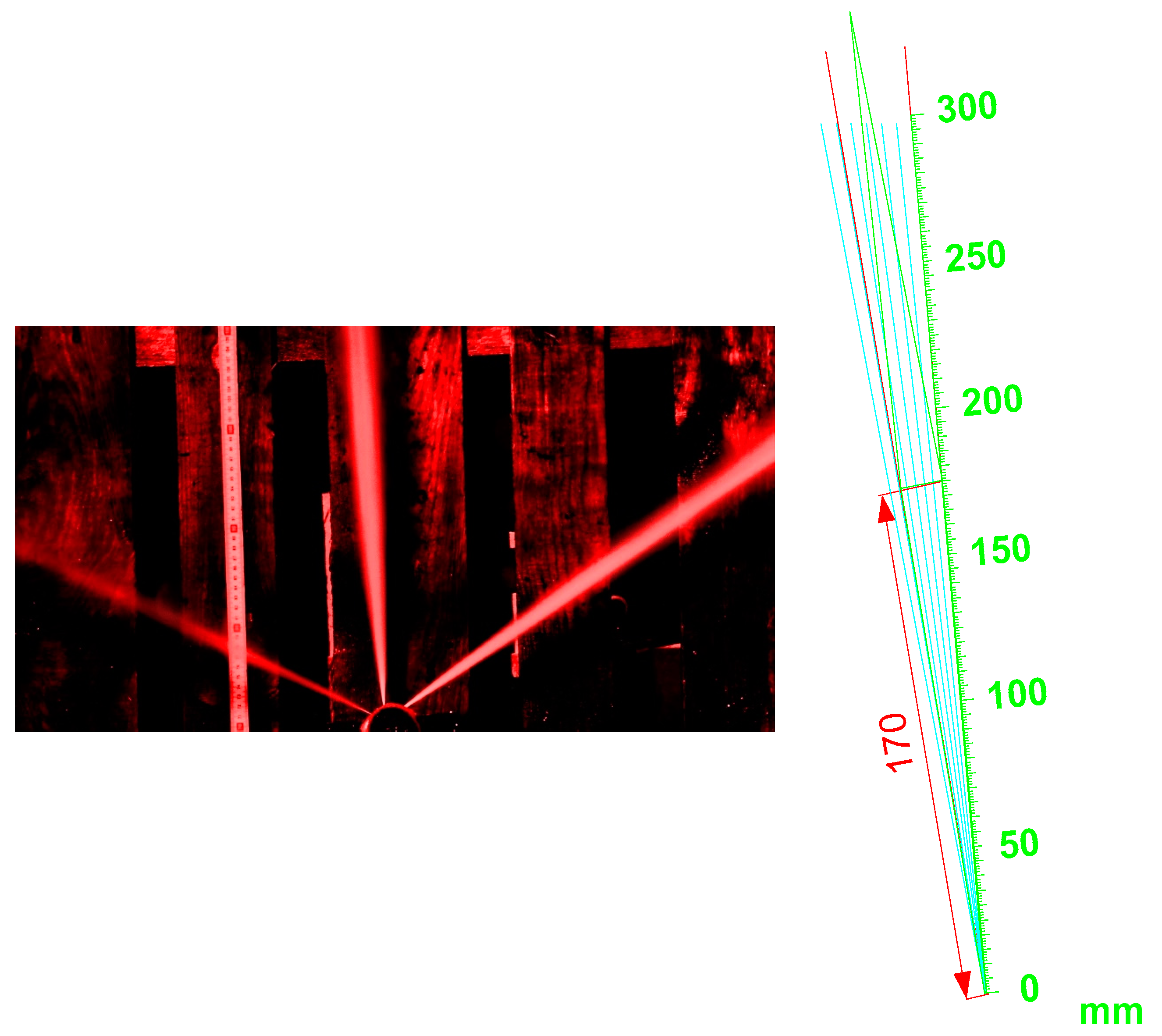

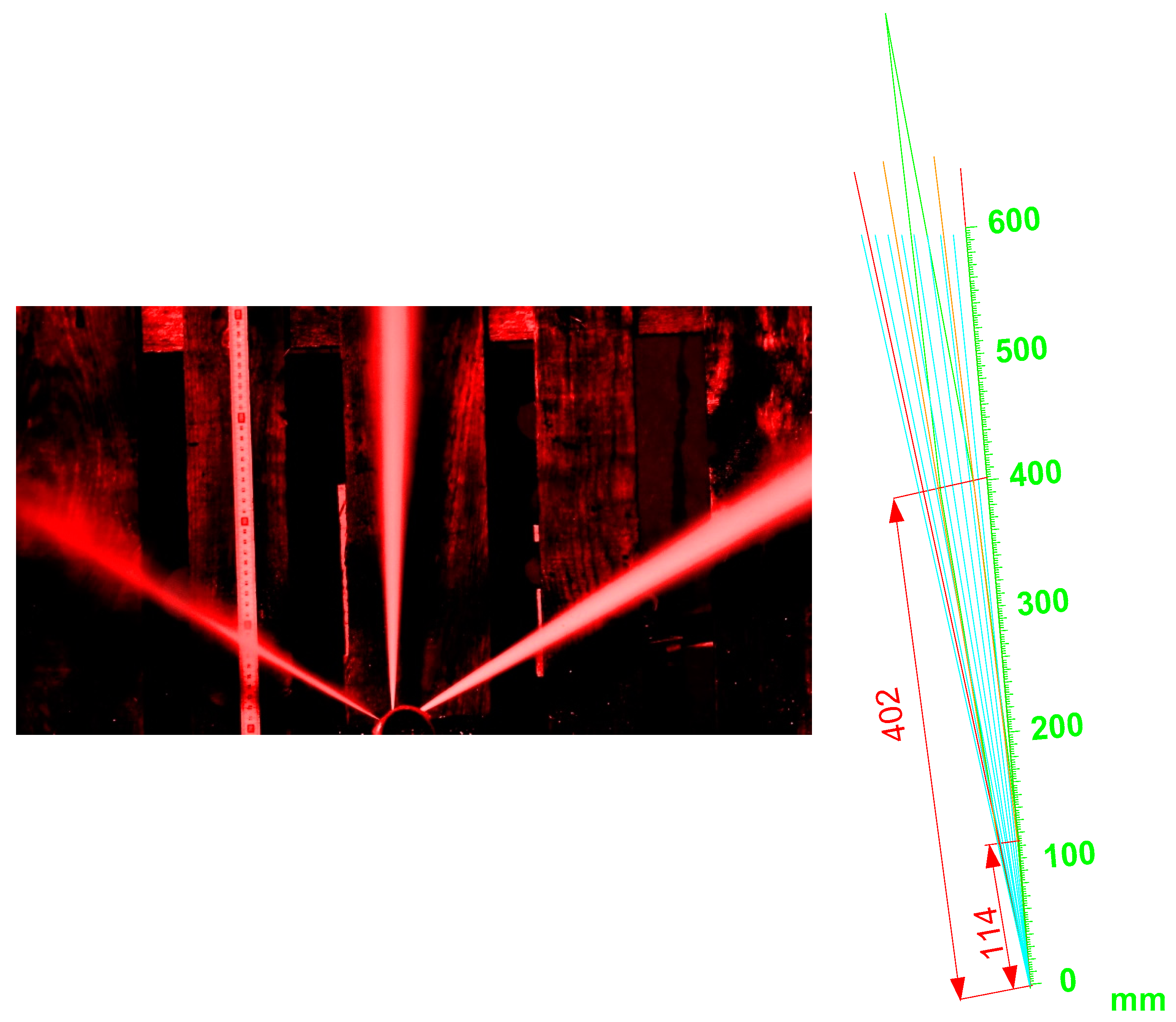


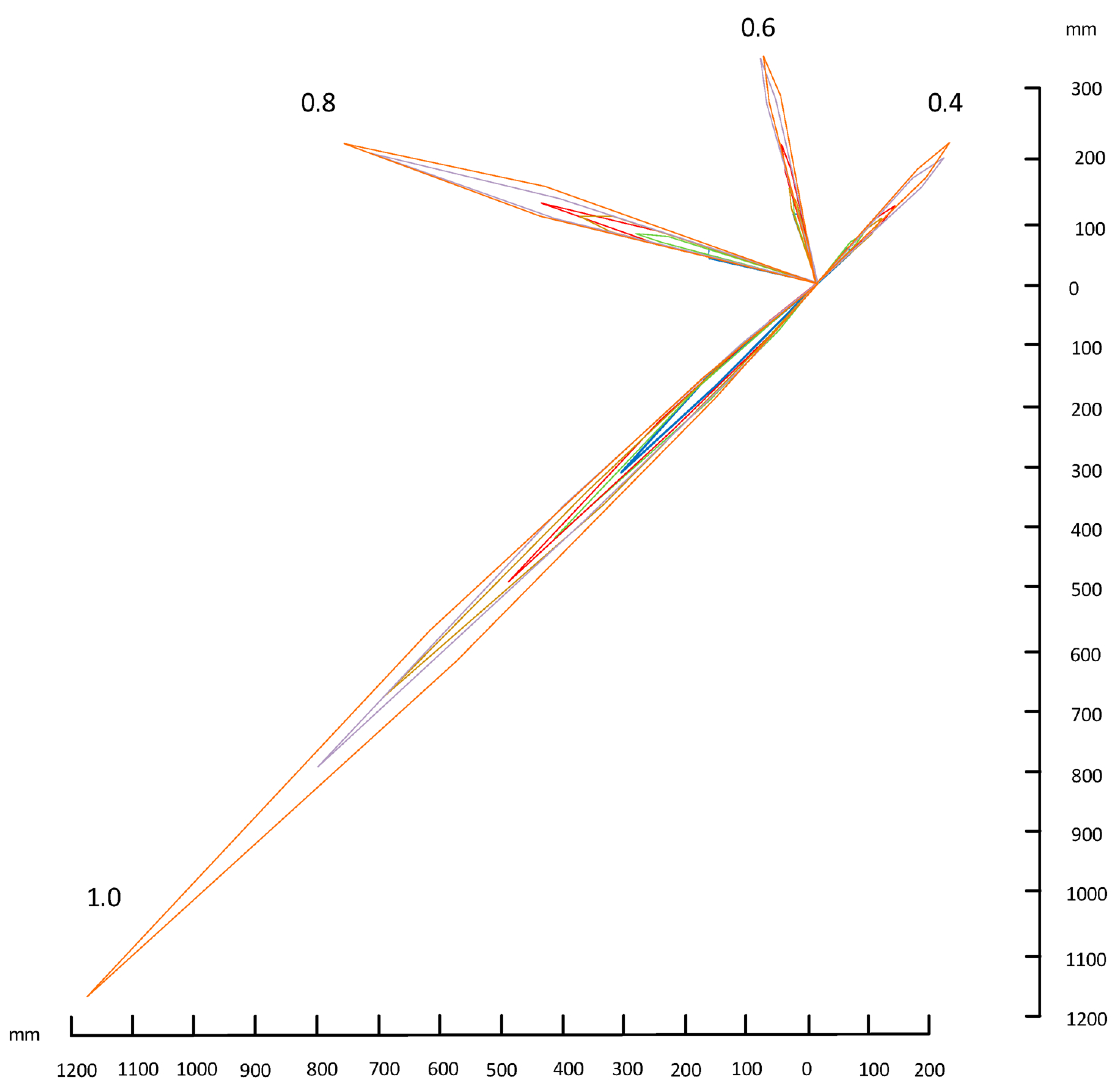
| Outlet Openings of Nozzle, mm | Pumping Pressure of the Working Fluid, MPa | |||||
|---|---|---|---|---|---|---|
| 10 | 20 | 30 | 40 | 50 | 60 | |
| 0.4 | 2.6 | 2.8 | 3 | 3 | 2.5 | 3.5 |
| 0.6 | 3.6 | 3.6 | 3.6 | 3.8 | 3.2 | 3.8 |
| 0.8 | 3.6 | 3.6 | 3.6 | 3.6 | 4 | 4.6 |
| 1.0 | 5 | 5 | 7 | 7.5 | 7.5 | 7.5 |
| Distance from the Drilling Head Toolface, mm | Pumping Pressure of the Working Fluid, MPa | |||||
|---|---|---|---|---|---|---|
| 10 | 20 | 30 | 40 | 50 | 60 | |
| 0 | 1 | 1 | 1 | 1 | 1 | 1 |
| 10 | 1.87 | 1.87 | 2.22 | 2.31 | 2.31 | 2.31 |
| 20 | 2.75 | 2.75 | 3.45 | 3.62 | 3.62 | 3.62 |
| 30 | 3.62 | 3.62 | 4.67 | 4.93 | 4.93 | 4.93 |
| 40 | 4.49 | 4.49 | 5.89 | 6.24 | 6.24 | 6.24 |
| 50 | 5.36 | 5.36 | 7.11 | 7.55 | 7.55 | 7.55 |
| 60 | 6.24 | 6.24 | 8.34 | 8.86 | 8.86 | 8.86 |
| 70 | 7.11 | 7.11 | 9.56 | 10.17 | 10.17 | 10.17 |
| 80 | 7.98 | 7.98 | 10.78 | 11.48 | 11.48 | 11.48 |
| 90 | 8.85 | 8.85 | 12.00 | 12.79 | 12.79 | 12.79 |
| 100 | 9.73 | 9.73 | 13.23 | 14.10 | 14.10 | 14.10 |
| 110 | 10.60 | 10.60 | 14.45 | 15.41 | 15.41 | 15.41 |
| 120 | 11.47 | 11.47 | 15.67 | 16.72 | 16.72 | 16.72 |
| 130 | 12.35 | 12.35 | 16.89 | 18.03 | 18.03 | 18.03 |
| 140 | 13.22 | 13.22 | 18.12 | 19.34 | 19.34 | 19.34 |
| 150 | 14.09 | 14.09 | 19.34 | 20.65 | 20.65 | 20.65 |
| 160 | 14.96 | 14.96 | 20.56 | 21.96 | 21.96 | 21.96 |
| 170 | 15.84 | 15.84 | 21.78 | 23.27 | 23.27 | 23.27 |
| 180 | 16.71 | 16.71 | 23.01 | 24.58 | 24.58 | 24.58 |
| 190 | 17.58 | 17.58 | 24.23 | 25.89 | 25.89 | 25.89 |
| 200 | 18.46 | 18.46 | 25.45 | 27.20 | 27.20 | 27.20 |
Disclaimer/Publisher’s Note: The statements, opinions and data contained in all publications are solely those of the individual author(s) and contributor(s) and not of MDPI and/or the editor(s). MDPI and/or the editor(s) disclaim responsibility for any injury to people or property resulting from any ideas, methods, instructions or products referred to in the content. |
© 2023 by the authors. Licensee MDPI, Basel, Switzerland. This article is an open access article distributed under the terms and conditions of the Creative Commons Attribution (CC BY) license (https://creativecommons.org/licenses/by/4.0/).
Share and Cite
Toczek, P.; Wisniowski, R.; Zlotkowski, A.; Teper, W. Hydraulic Radial Drilling Using a Rotary Hydraulic Nozzle Aimed at Increasing the Exploitation of Deposits. Energies 2023, 16, 7867. https://doi.org/10.3390/en16237867
Toczek P, Wisniowski R, Zlotkowski A, Teper W. Hydraulic Radial Drilling Using a Rotary Hydraulic Nozzle Aimed at Increasing the Exploitation of Deposits. Energies. 2023; 16(23):7867. https://doi.org/10.3390/en16237867
Chicago/Turabian StyleToczek, Przemyslaw, Rafal Wisniowski, Albert Zlotkowski, and Wojciech Teper. 2023. "Hydraulic Radial Drilling Using a Rotary Hydraulic Nozzle Aimed at Increasing the Exploitation of Deposits" Energies 16, no. 23: 7867. https://doi.org/10.3390/en16237867
APA StyleToczek, P., Wisniowski, R., Zlotkowski, A., & Teper, W. (2023). Hydraulic Radial Drilling Using a Rotary Hydraulic Nozzle Aimed at Increasing the Exploitation of Deposits. Energies, 16(23), 7867. https://doi.org/10.3390/en16237867








